What Is The Best Sports Bike For A Beginner rider? If you’re just starting out and looking for a fantastic entry point into the world of sportbikes, the best sports bike for a beginner offers a blend of manageable power, forgiving handling, and comfortable ergonomics. At usabikers.net, we understand the thrill of sportbikes and the importance of starting right. We’re here to guide you through selecting the perfect ride, ensuring a safe and enjoyable experience as you build your skills. This article will help you explore models that provide a balance of excitement and ease of use, perfect for newcomers to the sportbike scene. Discover the ideal beginner sportbike for a confident start.
1. Understanding the Needs of a Beginner Rider
What makes a sports bike suitable for a beginner? A beginner-friendly sportbike prioritizes ease of handling, predictable power delivery, and rider comfort. Key considerations include engine size, weight, seat height, and the availability of rider aids like ABS (Anti-lock Braking System). These elements combine to create a motorcycle that’s both thrilling and forgiving, allowing new riders to learn and improve their skills safely. According to the Motorcycle Safety Foundation (MSF), choosing a bike that fits your size and experience level is crucial for safety and confidence. At usabikers.net, we emphasize these factors to help you make an informed decision.
1.1. Manageable Engine Size
What is the ideal engine size for a beginner sports bike? An ideal engine size for beginner sport bikes typically ranges from 300cc to 500cc, offering enough power for excitement without being overwhelming. This range provides a balance that allows new riders to learn throttle control and gear management effectively. Bikes in this class often feature parallel-twin or single-cylinder engines, known for their smooth and predictable power delivery, which is essential for building confidence.
1.1.1. Benefits of Smaller Engines
Why are smaller engines beneficial for new riders? Smaller engines offer several advantages:
- Easier Handling: Lighter weight and lower power output make the bike more manageable.
- Forgiving Power Delivery: Smooth acceleration reduces the risk of unintentional wheelies or loss of control.
- Improved Fuel Economy: Save money while you learn.
- Reduced Intimidation: Less powerful bikes can be less daunting for new riders.
1.2. Lightweight Design
How does a lightweight design benefit beginner riders? A lightweight design improves handling and maneuverability, making the bike easier to control, especially at low speeds. Lighter bikes require less effort to steer and balance, which is crucial for new riders still developing their coordination and strength. According to a study by the AMA (American Motorcyclist Association), lighter motorcycles contribute to increased rider confidence and reduced fatigue.
1.3. Comfortable Ergonomics
Why are comfortable ergonomics important for a beginner sports bike? Comfortable ergonomics reduce fatigue and enhance control, allowing new riders to focus on learning proper riding techniques. A relaxed riding position, with an accessible reach to the handlebars and manageable seat height, prevents strain and discomfort, especially during longer rides. Ergonomics play a significant role in building confidence and ensuring a positive riding experience.
1.4. Essential Rider Aids
What rider aids should a beginner look for in a sports bike? Beginner riders should look for rider aids such as ABS (Anti-lock Braking System) and slipper clutches, as these technologies enhance safety and control. ABS prevents wheel lock-up during hard braking, reducing the risk of skidding, while a slipper clutch minimizes rear-wheel hop during aggressive downshifts, improving stability. These features provide an extra layer of safety and forgiveness, allowing new riders to learn from their mistakes without severe consequences.
2. Top Sports Bike Recommendations for Beginners
Which sports bikes are best suited for beginners? Several models stand out for their beginner-friendly characteristics. These bikes combine manageable power, lightweight designs, comfortable ergonomics, and essential rider aids, making them ideal for new riders looking to enter the world of sportbikes. Here are some of our top recommendations at usabikers.net:
2.1. Kawasaki Ninja 400
Why is the Kawasaki Ninja 400 a great beginner sports bike? The Kawasaki Ninja 400 is widely regarded as one of the best beginner sports bikes due to its lightweight design, smooth power delivery, and comfortable ergonomics. Its 399cc parallel-twin engine provides ample power for both city and highway riding, while its nimble handling inspires confidence. At a starting MSRP of $5,299, it’s also an affordable option.
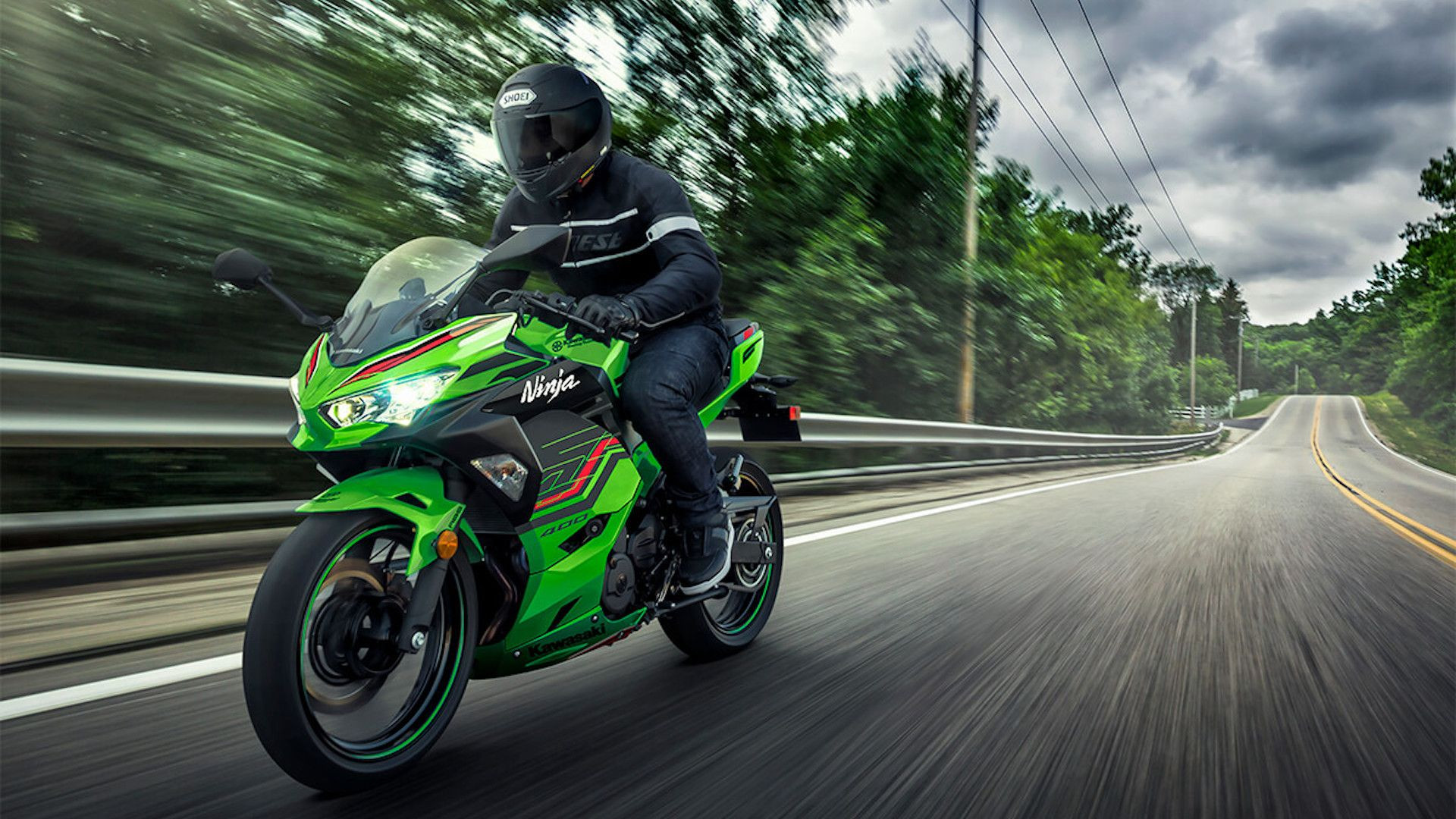 Ninja 400 KRT
Ninja 400 KRT
The Kawasaki Ninja 400 is a top choice for beginners.
2.1.1. Key Features of the Ninja 400
What makes the Ninja 400 stand out? Key features include:
- Engine: 399cc parallel-twin
- Power: 45 horsepower
- Torque: 27 pound-feet
- Weight: 366 pounds (wet w/ ABS)
- Seat Height: 30.9 inches
- Rider Aids: Optional ABS
2.1.2. Why It’s Great for Beginners
Why is the Ninja 400 ideal for new riders? The Ninja 400’s forgiving engine and lightweight chassis make it easy to handle, while its comfortable riding position reduces fatigue. It’s also a stylish bike that looks and feels like a larger sportbike, enhancing the overall riding experience.
2.2. Yamaha YZF-R3
What makes the Yamaha YZF-R3 a good beginner sports bike? The Yamaha YZF-R3 is an excellent option for beginners, offering a blend of sporty styling, manageable power, and agile handling. Its 321cc parallel-twin engine delivers smooth and predictable power, making it easy to control for new riders. Starting at $5,499, it’s also competitively priced.
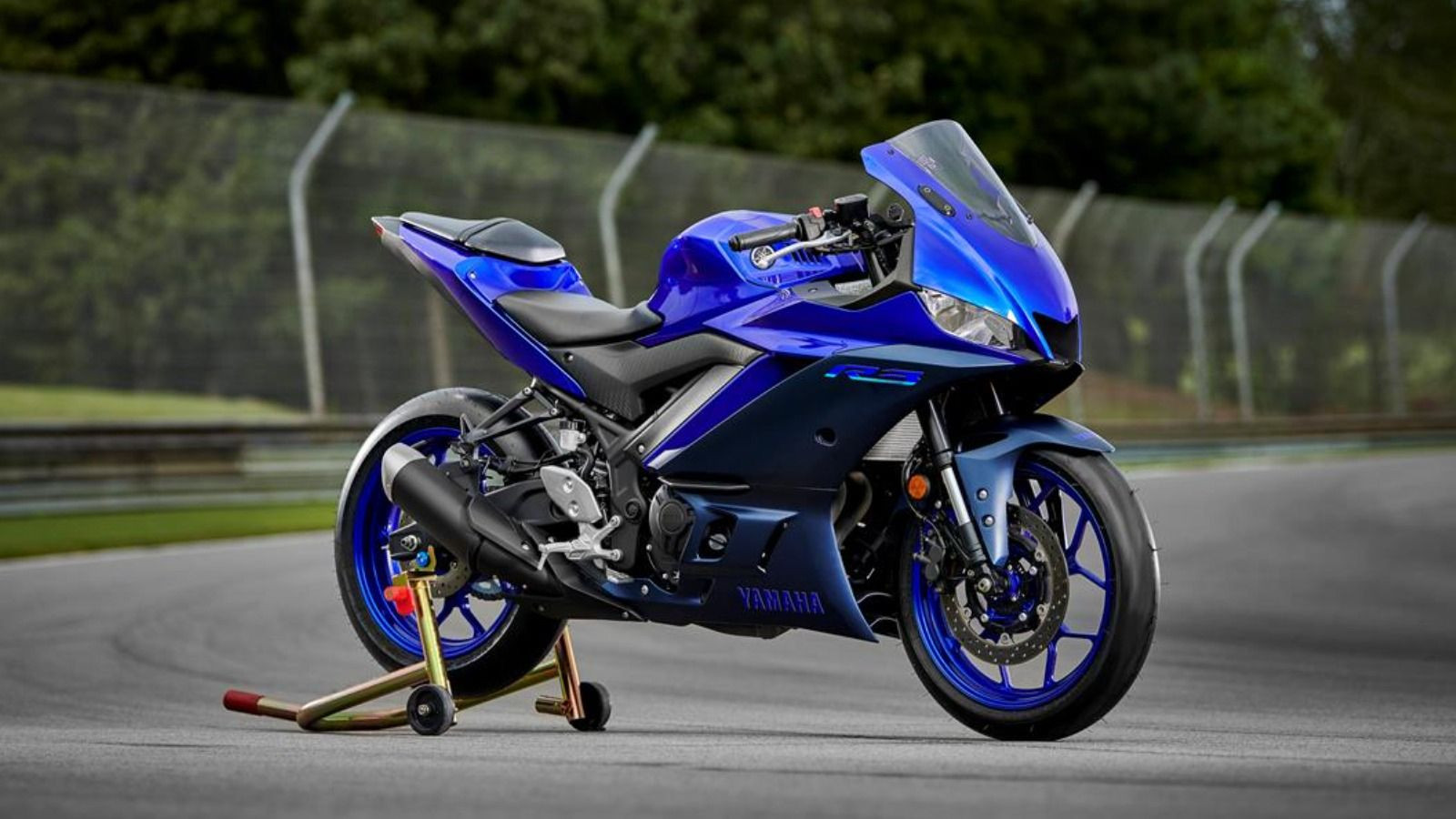 2023 Yamaha YZF-R3
2023 Yamaha YZF-R3
The Yamaha YZF-R3 is a well-rounded choice for beginners.
2.2.1. Standout Features of the YZF-R3
What are the notable features of the YZF-R3? Standout features include:
- Engine: 321cc parallel-twin
- Power: 42 horsepower
- Torque: 21.8 pound-feet
- Weight: 368 pounds (wet)
- Seat Height: 30.7 inches
- Rider Aids: Optional ABS
2.2.2. Beginner-Friendly Qualities
Why is the YZF-R3 suited for beginners? The YZF-R3’s lightweight design and responsive handling make it easy to maneuver, while its comfortable riding position ensures a pleasant experience. Its sporty aesthetics also appeal to new riders looking for a stylish entry into the sportbike world.
2.3. Honda CBR500R
Why is the Honda CBR500R a suitable sports bike for beginners? The Honda CBR500R is a step up in performance but remains manageable for beginners, offering a balance of power, comfort, and Honda’s renowned reliability. Its 471cc parallel-twin engine provides enough power for highway riding while remaining smooth and predictable. With a starting MSRP of $7,299, it offers a premium feel.
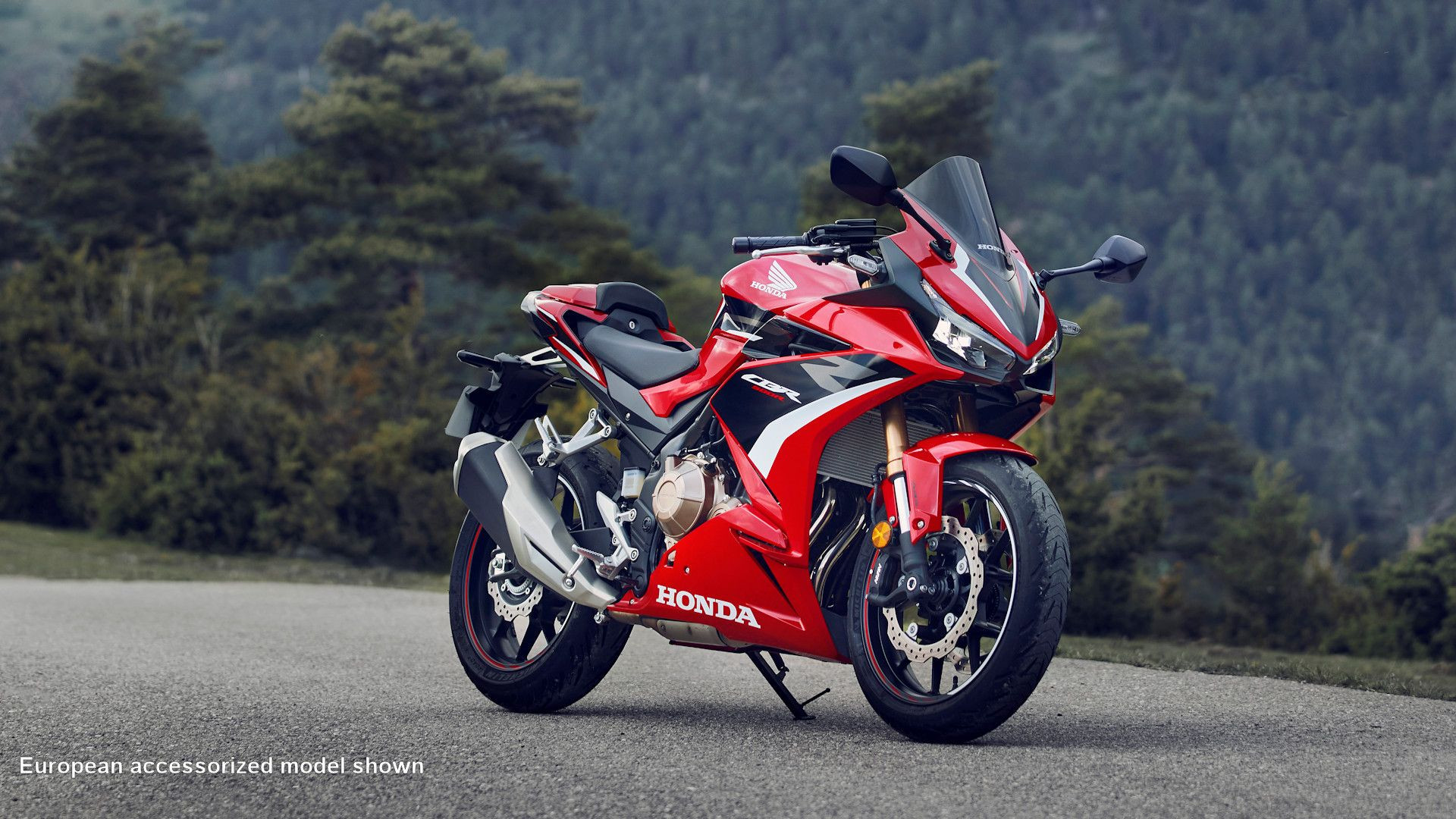 Red 2022 Honda CBR500R on the kickstand
Red 2022 Honda CBR500R on the kickstand
The Honda CBR500R provides a blend of performance and comfort.
2.3.1. Highlights of the CBR500R
What are the highlights of the CBR500R? Highlights include:
- Engine: 471cc parallel-twin
- Power: 50 horsepower
- Torque: 32 pound-feet
- Weight: 423 pounds (wet)
- Seat Height: 30.9 inches
- Rider Aids: ABS
2.3.2. Benefits for New Riders
Why is the CBR500R beneficial for new riders? The CBR500R’s refined engine and comfortable ergonomics make it suitable for longer rides, while its stable handling inspires confidence. It’s an excellent choice for beginners looking for a more versatile and capable sportbike.
2.4. KTM RC390
Why is the KTM RC390 a great starter sports bike? The KTM RC390 is a sporty and aggressive option for beginners, offering sharp handling and a punchy single-cylinder engine. Its lightweight design and track-inspired styling make it a thrilling choice for those looking to develop their riding skills. Starting at $5,899, it provides a premium experience in a smaller package.
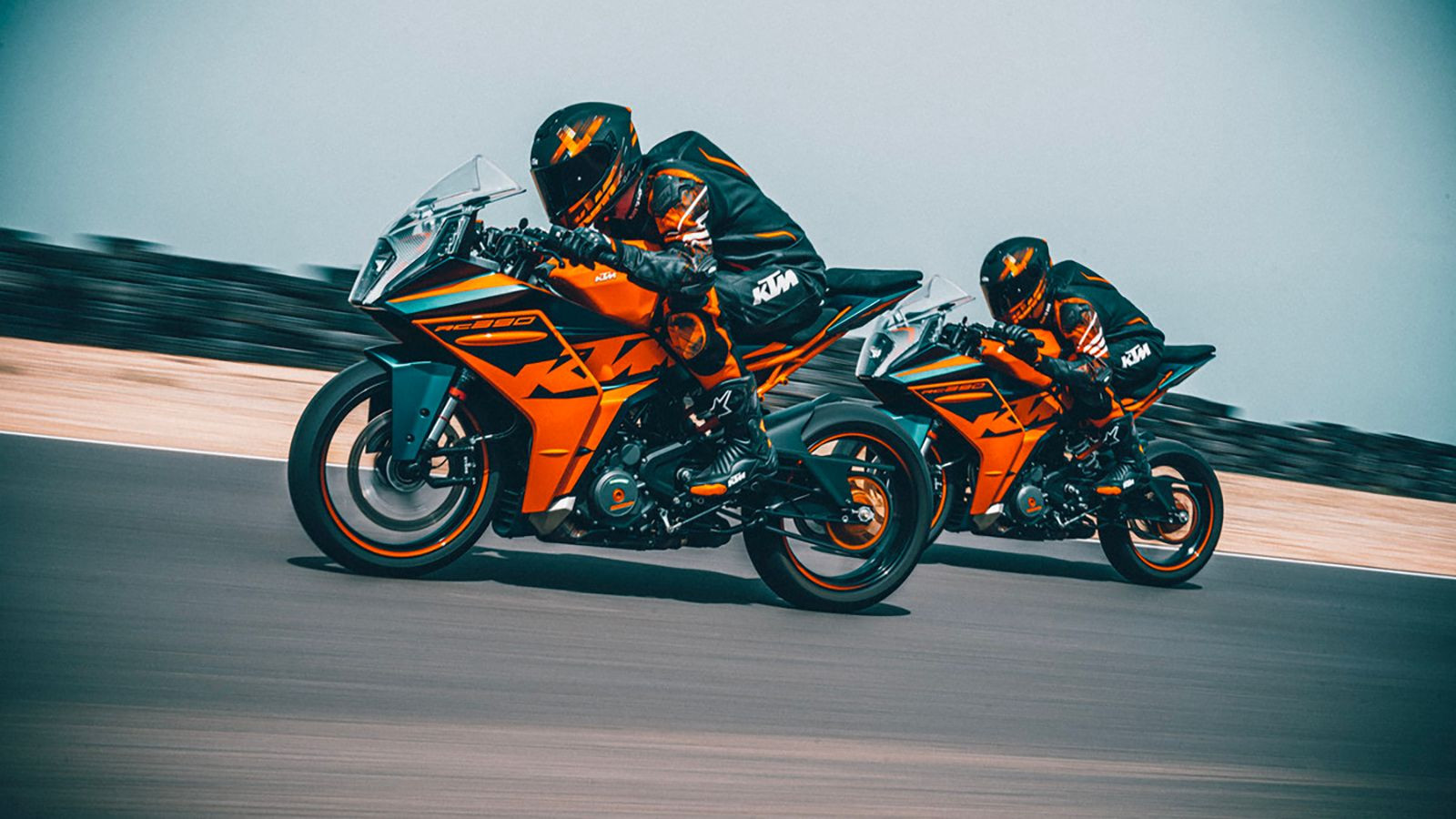 2022 KTM RC 390 On the track
2022 KTM RC 390 On the track
The KTM RC390 is a sporty and thrilling option for beginners.
2.4.1. Notable Features of the RC390
What are the notable features of the RC390? Notable features include:
- Engine: 373cc single-cylinder
- Power: 43 horsepower
- Torque: 27 pound-feet
- Weight: 342 pounds (dry)
- Seat Height: 32.5 inches
- Rider Aids: ABS
2.4.2. Advantages for Beginners
Why is the RC390 advantageous for beginners? The RC390’s lightweight chassis and responsive engine make it incredibly fun to ride, while its premium components, like WP suspension, enhance handling. It’s an excellent choice for beginners who want a sporty and engaging experience.
2.5. Suzuki GSX250R
Why is the Suzuki GSX250R a good beginner sports bike? The Suzuki GSX250R is a user-friendly and approachable option for beginners, offering a comfortable riding position and smooth power delivery. Its 248cc parallel-twin engine is unintimidating, making it easy to learn on. With a starting MSRP of $4,999, it’s one of the most affordable sportbikes.
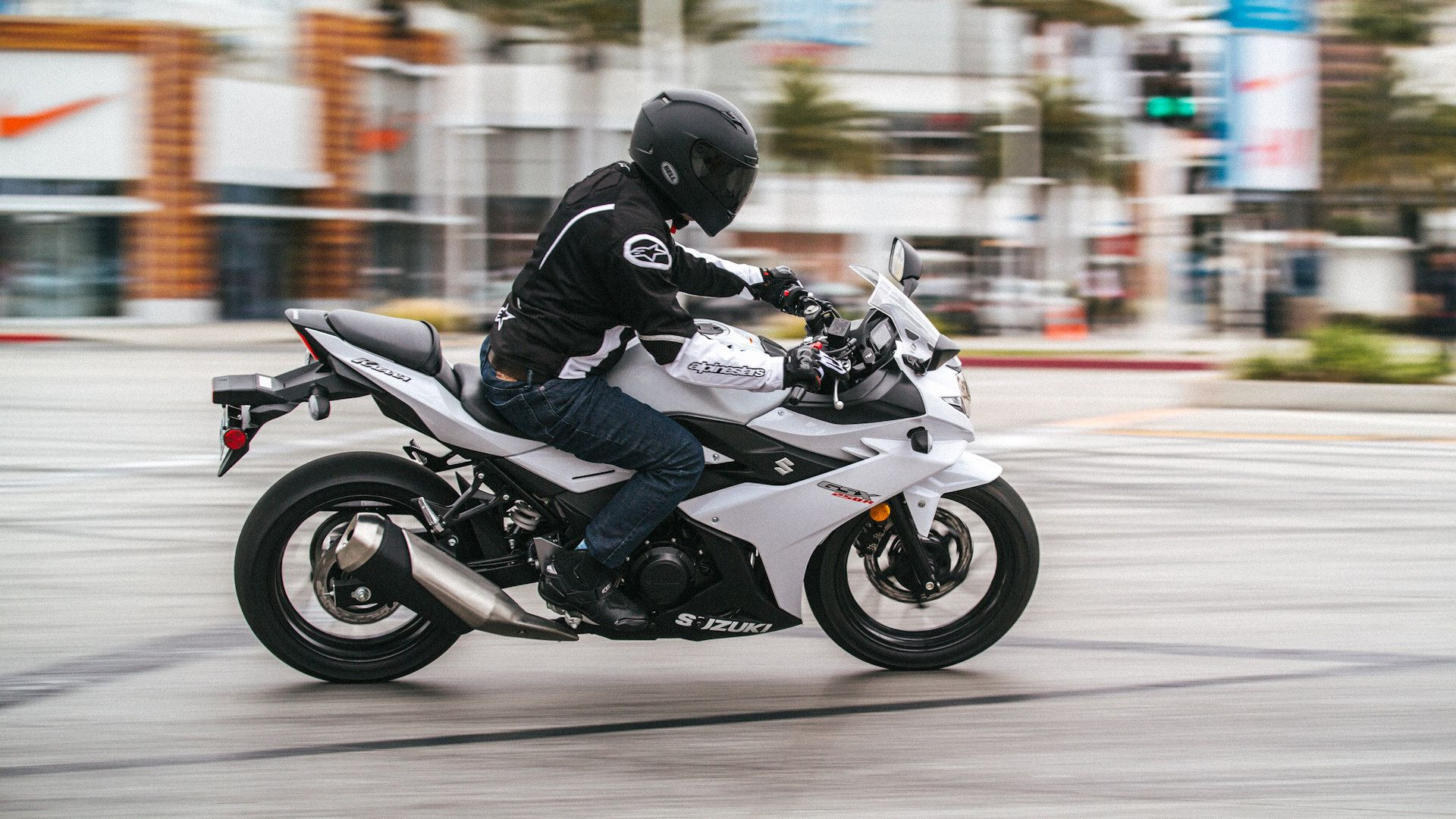 White Suzuki GSX250R cruising through town
White Suzuki GSX250R cruising through town
The Suzuki GSX250R is an approachable and affordable option.
2.5.1. Key Attributes of the GSX250R
What are the key attributes of the GSX250R? Key attributes include:
- Engine: 248cc parallel-twin
- Power: 24.7 horsepower
- Torque: 17 pound-feet
- Weight: 399 pounds (wet)
- Seat Height: 31.1 inches
- Rider Aids: None
2.5.2. Benefits for New Riders
Why is the GSX250R beneficial for new riders? The GSX250R’s relaxed riding position and forgiving engine make it an excellent choice for beginners who prioritize comfort and ease of use. Its stylish design and Suzuki’s reputation for reliability add to its appeal.
3. Factors to Consider When Choosing a Sports Bike
What factors should influence your sports bike selection? Choosing the right sports bike involves more than just reading reviews. It requires careful consideration of your individual needs, preferences, and circumstances. Here are some key factors to keep in mind:
3.1. Budget
How does budget influence your choice of sports bike? Your budget will significantly narrow down your options, as sportbikes range widely in price. Consider not only the initial purchase price but also ongoing costs like insurance, gear, maintenance, and potential modifications. At usabikers.net, we advise setting a realistic budget and sticking to it.
3.2. Riding Experience
How does your riding experience affect your sports bike choice? Your riding experience is a crucial factor in determining the right sports bike. Beginners should opt for models with manageable power and forgiving handling, while more experienced riders might prefer something more powerful and performance-oriented. Always be honest about your skill level to ensure a safe and enjoyable experience.
3.3. Intended Use
How does intended use impact your sports bike choice? Consider how you plan to use your sports bike, whether for commuting, weekend rides, or track days. Different models excel in different areas, so choose a bike that aligns with your primary riding needs. For example, a more comfortable and versatile bike is better for commuting, while a track-focused model is ideal for performance riding.
3.4. Fit and Comfort
Why is fit and comfort crucial when choosing a sports bike? Proper fit and comfort are essential for control and enjoyment. Make sure the bike’s seat height, handlebar reach, and overall ergonomics suit your body size and riding style. Test ride different models to find one that feels comfortable and natural.
3.5. Features and Technology
What features and technology should you consider? Consider the features and technology that are important to you, such as ABS, traction control, quick-shifters, and adjustable suspension. While not all features are necessary for beginners, some, like ABS, can significantly enhance safety. Evaluate which features align with your needs and preferences.
4. Essential Gear for Beginner Riders
What gear do beginner riders need? Safety is paramount when riding a motorcycle, especially for beginners. Investing in high-quality gear is essential to protect yourself in the event of an accident. Here’s a list of essential gear:
4.1. Helmet
Why is a helmet essential? A helmet is the most critical piece of safety gear, protecting your head from serious injury. Choose a helmet that meets DOT (Department of Transportation) or ECE (Economic Commission for Europe) safety standards and fits snugly. Full-face helmets offer the most protection.
4.2. Jacket and Pants
Why are a jacket and pants necessary? A jacket and pants provide abrasion resistance and impact protection in a crash. Look for gear made from leather or durable synthetic materials with armor in the shoulders, elbows, and knees.
4.3. Gloves
Why are gloves essential for motorcycle riders? Gloves protect your hands from abrasions and impacts, while also improving grip and control. Choose gloves with reinforced palms and knuckle protection.
4.4. Boots
Why should riders wear boots? Boots provide ankle and foot protection and offer better grip on the footpegs. Look for boots with ankle support, reinforced toes, and non-slip soles.
4.5. Protective Gear Standards
What safety standards should you look for in protective gear? Ensure your protective gear meets recognized safety standards such as DOT, ECE, or SNELL for helmets, and CE (Conformité Européenne) ratings for armor in jackets, pants, and gloves. These standards indicate that the gear has been tested and meets minimum safety requirements.
5. Mastering Basic Riding Skills
What basic riding skills are crucial for beginners? Before hitting the road, it’s essential to master basic riding skills in a controlled environment. These skills form the foundation for safe and confident riding.
5.1. Motorcycle Safety Courses
Why should beginners take a motorcycle safety course? Motorcycle safety courses, like those offered by the Motorcycle Safety Foundation (MSF), provide comprehensive training in basic riding skills and safety techniques. These courses are highly recommended for all new riders, as they significantly reduce the risk of accidents. According to the MSF, riders who complete a safety course are less likely to be involved in crashes.
5.2. Starting and Stopping
How do you properly start and stop a motorcycle? Practice starting and stopping smoothly and consistently. This involves coordinating the throttle, clutch, and brakes to avoid stalling or jerking. Start in a level, open area and gradually increase your speed as you become more comfortable.
5.3. Clutch and Throttle Control
Why is clutch and throttle control important? Smooth clutch and throttle control are essential for maintaining balance and preventing sudden acceleration or deceleration. Practice using the clutch and throttle together to achieve smooth starts, stops, and gear changes.
5.4. Shifting Gears
How do you shift gears smoothly? Practice shifting gears smoothly and efficiently. This involves coordinating the clutch, throttle, and shift lever to maintain a consistent speed and avoid jerky movements. Start with lower gears and gradually work your way up as you become more comfortable.
5.5. Turning and Cornering
How do you turn and corner safely? Learn to turn and corner safely by using proper body positioning, counter-steering, and throttle control. Practice turning at different speeds and angles to develop your confidence and skill.
6. Advanced Riding Techniques
What advanced riding techniques should you learn? Once you’ve mastered the basics, you can start to learn more advanced riding techniques to improve your skills and safety.
6.1. Counter-Steering
What is counter-steering and why is it important? Counter-steering is the technique of pressing the handlebar in the direction you want to turn, which causes the bike to lean into the turn. This is the primary method of steering a motorcycle at higher speeds. Practice counter-steering in a safe, controlled environment to become comfortable with the technique.
6.2. Trail Braking
What is trail braking? Trail braking is the technique of using the brakes while entering a turn to maintain stability and control. This allows you to adjust your speed and line through the corner. Trail braking requires practice and finesse, so start slowly and gradually increase your braking force as you become more comfortable.
6.3. Emergency Braking
How do you perform an emergency stop safely? Emergency braking involves applying maximum braking force without locking the wheels. This requires a combination of front and rear brake pressure and proper body positioning. Practice emergency stops in a safe, controlled environment to develop your reflexes and skills.
6.4. Hazard Avoidance
How do you avoid hazards on the road? Hazard avoidance involves scanning the road ahead for potential dangers and reacting quickly and safely. This includes avoiding potholes, debris, and other vehicles. Practice quick maneuvers like swerving and braking to improve your ability to avoid hazards.
7. Maintaining Your Sports Bike
Why is motorcycle maintenance important? Regular maintenance is essential to keep your sports bike running smoothly and safely. Here are some basic maintenance tasks you should perform:
7.1. Regular Checks
What regular checks should you perform on your sports bike? Perform regular checks of your bike’s fluids, tires, brakes, and lights. Check the oil level, coolant level, brake fluid level, and tire pressure regularly. Also, inspect the brake pads for wear and ensure all lights are working properly.
7.2. Oil Changes
How often should you change your motorcycle’s oil? Change the oil and filter according to the manufacturer’s recommendations. Regular oil changes keep the engine running smoothly and prevent wear. Use the recommended oil type and filter for your bike.
7.3. Chain Maintenance
How do you maintain your motorcycle chain? Keep the chain clean, lubricated, and properly adjusted. A well-maintained chain improves performance and extends its lifespan. Clean the chain regularly with a chain cleaner and lubricate it with chain lube.
7.4. Tire Maintenance
How do you maintain your motorcycle tires? Check the tire pressure regularly and inspect the tires for wear and damage. Proper tire pressure improves handling and extends tire life. Replace tires when they reach the wear bars or show signs of damage.
7.5. Brake Maintenance
How do you maintain your motorcycle brakes? Inspect the brake pads and rotors regularly and replace them when necessary. Also, bleed the brakes to remove air from the system and maintain optimal braking performance.
8. Joining the Biker Community
Why should you join the biker community? Connecting with other riders can enhance your experience and provide valuable support and camaraderie. Here are some ways to get involved:
8.1. Local Clubs
How do you find local biker clubs? Join a local motorcycle club or riding group. These clubs organize rides, events, and social gatherings, providing opportunities to meet other riders and share your passion for motorcycles.
8.2. Online Forums
Why should you participate in online forums? Participate in online forums and social media groups. These platforms offer a wealth of information and allow you to connect with riders from around the world. Share your experiences, ask questions, and learn from others.
8.3. Motorcycle Events
Why should you attend motorcycle events? Attend motorcycle events and rallies. These events showcase the latest bikes, gear, and accessories and offer opportunities to meet industry experts and fellow riders.
8.4. Group Rides
Why should you participate in group rides? Participate in group rides and organized tours. Riding with a group can be a fun and rewarding experience, allowing you to explore new roads and share the adventure with others.
9. Staying Safe on the Road
What are some essential safety tips for motorcycle riders? Staying safe on the road requires constant vigilance and adherence to safe riding practices. Here are some essential tips:
9.1. Defensive Riding
What is defensive riding? Practice defensive riding techniques. This involves anticipating potential hazards and reacting accordingly. Assume that other drivers don’t see you and be prepared to take evasive action.
9.2. Visibility
How can you improve your visibility on the road? Make yourself visible to other drivers. Wear bright clothing, use reflective tape, and ensure your bike’s lights are working properly.
9.3. Lane Positioning
Why is lane positioning important? Use proper lane positioning. Position yourself in the lane where you have the best view of the road ahead and are most visible to other drivers.
9.4. Following Distance
What is a safe following distance for motorcycles? Maintain a safe following distance. Give yourself plenty of room to react to sudden stops or changes in traffic.
9.5. Weather Conditions
How should you adjust your riding for different weather conditions? Adjust your riding for weather conditions. Reduce your speed and increase your following distance in wet or slippery conditions. Avoid riding in severe weather if possible.
10. Expanding Your Horizons
How can you continue to improve your riding skills and knowledge? As you gain experience, continue to expand your horizons and challenge yourself to become a better rider.
10.1. Advanced Training
Why should you consider advanced riding courses? Take advanced riding courses. These courses offer specialized training in areas like cornering, braking, and hazard avoidance.
10.2. Track Days
Why should you participate in track days? Participate in track days. Track days provide a safe and controlled environment to push your limits and improve your riding skills.
10.3. Long-Distance Riding
Why should you try long-distance riding? Try long-distance riding. Touring can be a rewarding experience, allowing you to explore new places and challenge yourself physically and mentally.
10.4. Continuous Learning
Why is continuous learning important? Stay informed about the latest safety tips, riding techniques, and motorcycle technology. Read motorcycle magazines, watch online videos, and attend seminars to expand your knowledge.
Choosing the best sports bike for a beginner involves considering factors like engine size, weight, ergonomics, and rider aids. Models like the Kawasaki Ninja 400, Yamaha YZF-R3, Honda CBR500R, KTM RC390, and Suzuki GSX250R offer a great starting point. Remember to prioritize safety by investing in essential gear, mastering basic riding skills, and continually expanding your knowledge.
At usabikers.net, we are dedicated to providing you with the resources and community you need to embark on your motorcycling journey. Explore our site for more in-depth reviews, guides, and forums to connect with fellow riders. Ride safe and enjoy the journey and share your experience with street bikes!
Ready to find the perfect beginner sports bike and connect with a vibrant community of riders? Visit usabikers.net today to explore our comprehensive guides, reviews, and forums. Start your motorcycling adventure with confidence and join a community that shares your passion.
Address: 801 Sturgis Main St, Sturgis, SD 57785, United States.
Phone: +1 (605) 347-2000.
Website: usabikers.net.
FAQ Section
1. What is the most important factor to consider when buying a sports bike as a beginner?
The most important factor is manageability. Look for a bike with a smaller engine (300-500cc), lightweight design, and comfortable ergonomics.
2. Is ABS necessary for a beginner sports bike?
While not mandatory, ABS is highly recommended as it can prevent wheel lock-up during hard braking, increasing safety.
3. What is the best way to learn how to ride a sports bike?
Enrolling in a motorcycle safety course like the MSF Basic RiderCourse is the best way to learn the fundamentals in a safe and controlled environment.
4. How much should I budget for a beginner sports bike?
Budget should include not only the cost of the bike but also gear, insurance, and maintenance. Expect to spend between $5,000 to $8,000 initially.
5. What kind of gear do I need as a beginner rider?
Essential gear includes a DOT-approved helmet, riding jacket, gloves, pants, and boots.
6. Can I start on a 600cc sports bike as a beginner?
While possible, it’s generally not recommended. 600cc bikes have much more power and can be difficult to handle for new riders.
7. How often should I service my sports bike?
Follow the manufacturer’s recommended service intervals, typically every 3,000 to 6,000 miles, or annually.
8. What are some common mistakes beginner riders make?
Common mistakes include improper throttle control, poor clutch coordination, and not looking far enough ahead.
9. How can I improve my cornering skills?
Practice counter-steering, body positioning, and trail braking in a safe environment, such as a track day or advanced riding course.
10. Is it better to buy a new or used sports bike as a beginner?
Buying used can save money, but ensure the bike is in good condition. Have a mechanic inspect it before purchasing to avoid costly repairs.

